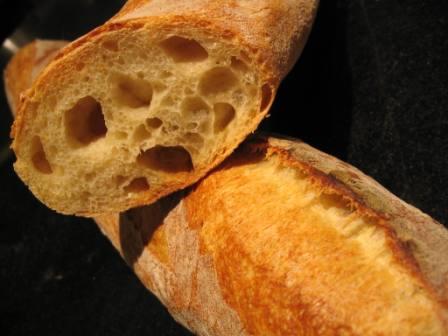Last week, I received the book "100% Pain" by Eric Kayser that I had ordered. I had always wanted to try the recipe for his famous "Baguette Monge". First, I was surprised to see the note stating that all the recipes in the book have been tested on a bread machine and second that recipes for all his breads call for straight room temperature fermentation. Checking his website, I found a quote saying that his breads all go through a long fermentation, so being the tinkerer that I am, I decided not to follow his recipe verbatim but instead to use the same formulation (more or less) and modify the execution.
I have been experimenting making baguettes using the James MacGuire techniques that Shiao-Ping had introduced to TFL a couple of weeks ago and have found them simple and easy, resulting in a beatifully developed dough. The baguettes were very good but I thought the high hydration made shaping and scoring the baguettes difficult and the crumb, although light was not as open as I would have liked. MacGuire had warned about the same effects of high hydration on baguettes in his article in "The Art of Eating".
I have had good success with the Anis Bouabsa baguette recipe and techniques that David (dmsnyder) had adapted from Janedo. I found that the cold delayed fermentation helps develop a more chewy and open crumb and gives the bread a more complex flavor.
So, this past weekend, I decided to combine these favorite techniques and use them to make my version of Eric Kayser's "Baguette Monge". I will call it the "Kayser Baguette Monge Hybrid". Here is the formulation:
Kayser uses a Type 65 Flour so I chose a flour mix that approximate the original. The resulting protein content is around 12.5%. Note that although the French Flours have lower protein content US Flours, I read that most French bakers add Malted Barley Flour and Vital Wheat Gluten to their dough.
Kayser uses 58% hydration. I upped it to 72%.
- 100 Gms Liquid Levain (100% hydration)
- 300 Gms KAF AP Flour
- 150 Gms KAF Bread Flour
- 50 Gms KAF WWW Flour
- 345 Gms Water
- 1 Gm Instant Yeast
- 9 Gms Sea Salt
Mix the Levain with the Water then add the Flour Mix, Salt and Yeast. Mix by hand for 2 mins and follow the MacGuire stretching and folding in the bowl at 45 mins interval instead of 1 hr.
At the end of the folding, the dough should rise by 25%. Cover and refrigerate for 24 hours. The dough should double in size.
Divide the dough into third and shape into boules. Rest seam side down for 1 hr.
Shape into baguettes with pointy ends and proof for 45 min.
Score the loaves and bake in preheated 460 degrees F oven with steam for 10 mins.
Continue baking at 430 degrees F without steam for 12 mins.
Turn of heat and let baguettes rest for 5 mins in oven.
Remove baguettes and let cool on rack.

The baguettes crackled and popped while cooling on the rack and developed nice "shingles".

The grignes opened up nicely and the crust had a beautiful amber color and toasty caramel aroma.

The oven spring was great and the cross section came out nice and round. The crumb was cream color and very open with different size "alveoles". The gelatinization made it slightly translucent.
The crust was thin and crackly with notes of roasted hazelnut and mocha. The crumb had a nice chewy mouthfeel with a tangy, creamy and sweet toasty wheat finish.
This was definitely the best baguette that I have baked to date , a real keeper.
And the quest for the Ultimate Baguette continues...
Don